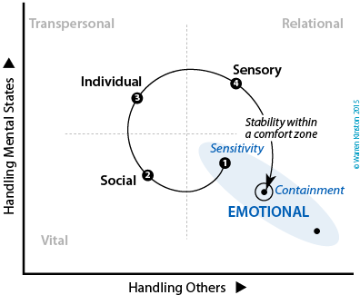Re-enter Mode-1: Containment
The Watershed
Having reached the (Stage-4), the is now strong—strong enough to refer confidently to "a self". A person feels well-individualized. Because of the values and attitudes that have cumulated to this point, the quality of the now shifts.

Less attention needs to be given to handling mental states because:
- social integration in provides automatic conventions and norms that modulate and channel feelings;;
- the self-concept in provides a base for assertion and self-direction as well as a preference for keeping feelings private; &
- a flow of good feelings including reassuring and soothing recognition is received in .
At the same time, the cumulation of values from the and makes it easier to handle complexity.
So the spiral trajectory re-enters the further down the ellipse. This new position is best characterized as . of feelings, or , is a state in which the self is both sensitive and stable. The resulting stability of feelings makes it much easier to function smoothly on most occasions.
The boundaries within which stability is assured define a «comfort zone». Outside the comfort zone, a person is liable to become overtly and even intensely emotional—which is why people do not want to leave that zone.
The initial values of the now manifest a subtle but significant adjustment due to inputs from .
- now generates far less volatility.
- becomes less urgently desired.
- are less depended on.
- occurs with less intensity.
- involves more diversity.
- are more durable and dependable.
- is aided by self- and social-acceptance.
Having provided satisfactory control of one's own , the completion of is an attractive settling point in the individualizing process.
Recap of Cycle 1
The function of is to ensure that a person has sufficient control over their —while being and feeling wholly themselves as a person with a distinctive character.
![]() Recap how this control develops:
Recap how this control develops:
At each of these 4 , a person may feel content with their self and its degree of strength and individuality. If so, there is no call for further progress. Such a choice will depend on situational factors (e.g. age, community), as well as personal aspirations and, perhaps, the preferred .
While at the end of can exist and function in a constructive, comfortable and balanced fashion, something more is offered in which allows exploration and activation of additional personal potentials.
Significance & Meaning in Cycle-2
The inner self-oriented concern may strive to go beyond stability. There may be an inner drive for the and its well-being to become more meaningful in either or both personal and social terms.
If well-being is to become more meaningful, then the 'self' must become less 'selfish'. That means raising one's horizons and making a special effort.
through calls for understanding and reflection: it is a process that can be termed: self-actualization. It shows as a willingness to alter belief systems and to move outside of comfort zones.
Exploring and developing inner potentials is a multi-stage process. The first step is to become energized for greater things and this can only emerge from the .
■ involves moving back along the X-Axis to the and getting energized by vigorous engagement with something challenging and meaningful.
■ involves opening up to the universe and perceiving meaning in all events and people via the , and allowing that focus to affect and develop the .
■ allows a return to one's more worldly self in the but now ensuring that is assigned a special meaning and unique value.
■ This then leads spontaneously to a return to the but at the far lower right extreme of the ellipse where the handling of feelings is via .
- Move to Stage-5: Vital Mode.
Originally posted: 7-Jan-2016. Last amended: 23-Jun-2016.